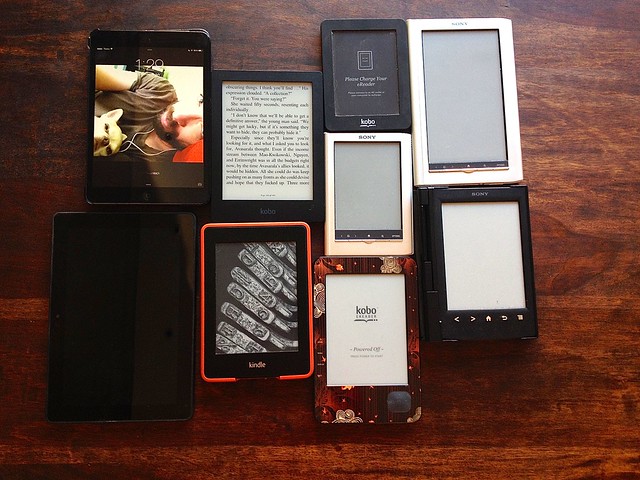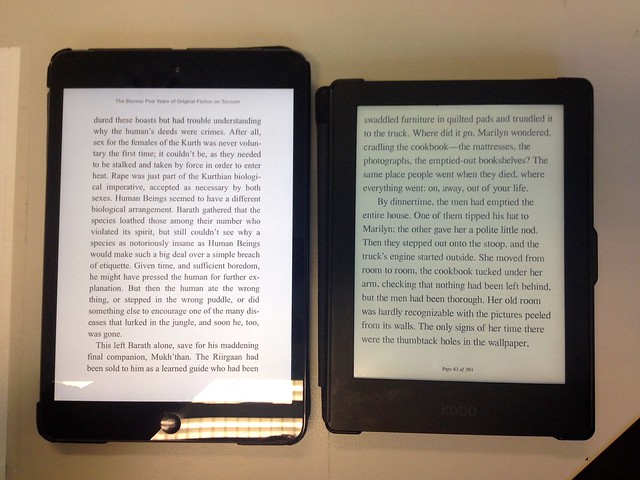So how many ereaders does a person need?
I think it’s fair to say that I would not be the right person to ask this question: this picture shows the NINE devices I own which I use for reading.
From top left: iPad Mini (1st gen), Kobo Aura HD, Kobo Mini, Sony Daily Edition PRS-950, Sony PRS-T2, Kobo (1st gen), Sony Pocket Edition PRS-350, Kindle Paperwhite (1st gen), Kindle Fire HDX 8.9″.
So two of these are tablets, the rest are e-ink ereaders.
I love e-ink ereaders. (Could you tell?)
According to some people, the dedicated ereader is “dying”. People are reading on their smartphones or tablets instead, apparently. I don’t know. It seems as though the people who are writing these sorts of articles focus on ever-increasing sales. Unless the device or gadget they are writing about has millions and millions of sales every month, it’s “dying”. But surely, most people who get ereaders just settle down and get reading on their device and don’t worry about buying another, unless the device breaks, or a newer model promises some amazing new feature? (Unless they’re me, of course. But I think we’ve established that I am a bit weird in this area.)
The first generation Kobo is the first ereader I bought. It is very slow compared to current model ereaders, but at the time it was a great introduction to e-ink, and I loved it. I should note that at the same time as I got the Kobo, I also had a first generation iPad. There was no way the iPad could compete with the Kobo when it came to reading novels, as the iPad was bulky and heavy when compared to the Kobo, which weighed less than many paperbacks. The first generation Kobo also feels good in the hand, with its quilted back, which no other ereader since has replicated, as far as I know.
The next ereader I bought was the 7″ Sony Daily Edition PRS-950. I loved that ereader. It had a much crisper display than the old Kobo, and it was much faster too. And the Sonys all feel much more solid than the other ereaders I have, as they have nice metal bodies. The Sonys don’t have in-built screen lighting, though…
From the Sonys I moved on to a Kindle Paperwhite. Now, I really really like the form factor of the Kindle Paperwhite. It feels nice to hold. It was also the first ereader I’ve owned that has a built-in light for the screen.
The iPad mini is definitely much nicer as an ereader than a full-sized iPad, but I still prefer e-ink. I can get very distracted with my iPad. I have to look things up, or notifications pop up that I just have to check. I also get tired looking at the backlit screen, and let’s not forget the far shorter battery life when compared to an e-ink reader.
Here is a comparison of the iPad Mini (non-retina screen version) with an e-ink screen (Kobo Aura HD, screen light off):
I have a Kindle Fire too. Meh. It’s never really done it for me. I don’t enjoy the reading experience as much as on an iPad, and too much of the video and audio content available via Amazon is not available to me as an Australian, so the tablet hasn’t managed to wow me.
My latest ereader is a Kobo Aura HD. I have to say I LOVE this ereader. What do I love about it?
- the screen light can be switched off. (The Kindle Paperwhite’s light can be turned down but not switched off)
- it’s very easy to install fonts. Yay, I can have my favourite, Times. (Yes, yes, I’m boring.) I have even installed some Chinese fonts. Maybe I’ll start reading Chinese novels.
- the screen is slightly bigger than the Kindle Paperwhite’s.
- it accepts micro-SD cards, up to 32GB. (I have to say I actually don’t care to store huge numbers of books on my ereader – I can’t be bothered having to scroll through pages and pages of titles – but I love having the option)
Some reckon it’s the best ereader available.
This picture below shows paper and an e-ink screen. I think I mucked up the lighting, so the ereader is slightly in shadow. I find reading on e-ink much more comfortable than reading on paper – mainly because I can adjust the font sizes to ease my presbyopic eyes! I do also love being able to change fonts on a whim… And the lightness of an ereader, compared to bulky paper, is a plus.
All my ereaders still work, with the exception of the first-generation Kobo, which got borked during its last software update, somehow. Here’s the point where I confess to shameful bright-and-shiny-itis and over-indulgence in new technology. But you might have worked that out already.
~~~~~
Today’s topic: “Free topic (write about whatever you want)”.
Which is just as well, given that I have missed the last three days.



2 Comments
I haven’t used my ereader much in recent times for reading and have been using my nexus 7 more and more. The nexus is sufficiently light and I don’t have notifications turned on so there’s nothing to distract when reading. I’m liking it more for reading in bed at night too as my reading app, cool reader, has a night mode to reduce brightness.
Though I’m currently tempted by, “oh look, new shiny thing”, the new Sony Experia Z2 10″ tablet. Handled one recently and it had an instant *wow* factor. That would also solve my screen size issue with reading magazines in zinio…honest 🙂
The big advantage of dedicated eReaders for families and kids is that they can only be used for reading, and are free from annoying and distracting games and apps. If your child is using one you can be pretty sure what they are doing. At school, kids are allowed to use eReaders in silent reading sessions, but not iPads and the like.